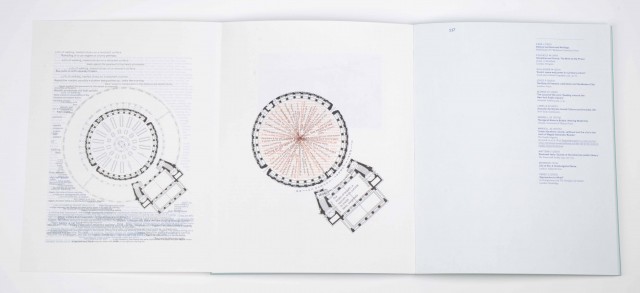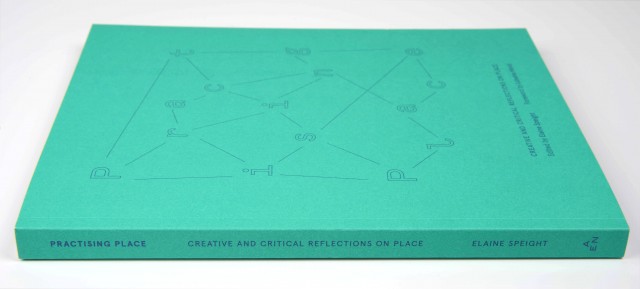“The democratic art of conversation-based writing”: Practising Place Book Review

What might a dating agency for artists and researchers look like? Sara Jaspan on a new book that brings together different people with the same interests in art and ideas…
In his co-authored contributing chapter to Practising Place (2019), a new book published by Art Editions North, researcher, typographer and writer Paul Wilson remarks: “It’s no surprise that the words ‘community’ and ‘communication’ share a root and that their linguistic histories begin in the same place: with the Latin word ‘communis’ which translates as ‘to share’ or – when used as a verb – to make something common.” It is this egalitarian impulse that lies at the heart of the publication and the wider six-year programme of activity out of which it grew, conceived and coordinated by curator Elaine Speight from the art-led research project In Certain Places in Preston. Some of the earlier essays – on demolition, sound and urban decay, amongst other themes – have been published online here with The Double Negative, and lay the ground for the chapters in the book.
Beautifully designed by Textbook Studio at Islington Mill and with a foreword by Turner Prize winner Lubaina Himid, Practising Place consists of nine free-form experiments in collaborative writing. Each developed out of a series of conversations between paired members of two often siloed communities – academics from the field of humanities and social sciences, and artists – matched by Speight, who provided something of “a research dating agency” service, as described by one participant.
While the overarching focus of the book pivots around our relationship with place, it is inevitably shaped by the northern locality of its production, and the unexpected pockets of niche interest that each set of authors has been afforded the time and space to stumble upon and explore, thanks to the unusually non-goal orientated nature of the project.
These niches include the extensive image collection of “weird rural things” that artist Rebecca Chesney and art historian Rosemary Shirley discovered they share, and which forms the basis of Dry as a Badger and Other Rural Mythologies. Framed around an earlier piece by Chesney that parodies homeware colour sampling charts, the visual essay humorously satirises our romanticised perception of the countryside as an inherently ‘natural’ space – a myth largely “made up by people who want to sell us things” and propagated by political agenda.
Similarly, artist Jenny Steele and tourism researcher David Jarratt coalesce around the notion of ‘seasideness’ – a term developed by Jarratt to refer to the unique ‘genus loci’ of many northern coastal towns, and which perfectly captures the specific blend of salty air and bittersweet nostalgia that has gripped Steele’s work over the last few years. Meanwhile, artist Emily Speed and human geographer Duncan Light found themselves equally fascinated by the desire lines, or desire paths, that run through a city – representing traces of civic disorder and subversion in the face of urban authority (contraventions visually echoed by Speed’s textual trespasses across the body of Light’s words).

Other chapters are devoted to subjects including Stanlow Oil Refinery in Ellesmere Port, the community noticeboards of northern working-men’s clubs, and the ancient practice of ‘beating the bounds’ (marking the perimeter of a ward, parish or city “by perambulating around its extent”) which originated during the pre-Conquest period in England and still continues in some areas today. Yet, amidst the book’s appealingly broad array of narrowed subjects, overlapping themes do emerge. Most notably, perhaps; the unspoken yet apparent need to reconnect with our physical surroundings and regain a sense of ‘hereness’. To “re-sensitise ourselves to the dynamic presence of place,” in the words of Mike Collier from Art Editions North, who spoke at the book launch of Practising Place earlier in March at the Whitworth, Manchester.
This comes across strongest in artist Amelia Crouch and literary geographer David Cooper’s short-story style contribution – The Supermodernity of Center Parcs – which playfully critiques the heterotopian ‘placelessness’ of the chain holiday resort; “where all roads lead you back to where you came from” and which is pretty much the same across any of its four UK sites. Centred around a ‘Subtropical Swimming Paradise’, numerous (reassuringly familiar) global eatery brands, and a plethora of hyper-bucolic nature-inspired simulacra, Center Parcs allows visitors to effortlessly slip from one non-place to the next.
As with several of the book’s other authors, Crouch and Cooper also touch upon the disconnecting impact of the screens and mobile devices which now afford individuals the ability to “live rather oddly in an intellectual, musical or visual environment that is wholly independent of his [or her] immediate physical surroundings” (Marc Augé). Artist Victoria Lucas and sociologist Emma Fraser likewise venture into the intangibility of the digital realm in their experimental feminist text, Place Pixilation, where Lucas’s poetic interventions appear to describe the outer-body experience of virtual reality: “I fall, but don’t feel the full sensation of falling. I have complete control of gravity, I move forward and back at will. Even if I hit the ground, I can reverse the action or just stand, unscathed by my volatile movements.”
Rather than rooting our increasing separation from place solely in the present, however, artist and field recorder Magda Stawarska-Beavan and historian Dr James G Mansell take a slightly longer view. Their chapter considers the ongoing historic characterisation of everyday noise as a destructive force from which refuge must be sort; ignoring the role that the sonic ‘infraordinary’ (as described by the French writer Georges Perec) has to play in producing and connecting us to place and a sense of tactile reality. Sound can interrupt the intellectual at work, or simply the busy and fragmented mind in its attempt to focus, but, as Mansell writes: Stawarska-Beavan “shows us that to hear is to belong.”

Her contribution to the chapter relates to her own experiences of deep listening, and of recording the acoustic environment of Manchester Central Library using binaural equipment for a new artwork, Resonating Silence (2018). Following Stawarska-Beavan’s sonic journey across St. Peter’s Square, through the library entrance hall, and into the domed Reading Room, has a grounding impact even as we read about it from elsewhere.
She recounts “the voice of the Big Issue seller calling the same words like a mantra, punctuated by a tram bell […] The woosh of the doors followed by the hum of the overhead heater […] the sound of my heels muffled by the soft, grey carpet […] a pencil against paper, shuffles of a chair.” A fold-out map showing the architectural plans of the building overlaid with artist Heather Ross’s textural interpretation of Stawarska-Beavan’s recordings further highlights the importance of sound as one of the key, yet often overlooked factors in how we experience space.
The overall highlight of Practising Place is the experiment it constitutes in the more democratic art of conversation-based writing, and the range of perspectives that each of the contributors offer. As was discussed during the speeches at the launch, one of the main barriers to producing an independently-published book of this kind is the pressure placed on academics by universities (in response to government demands), to focus their publishing efforts primarily on appearing in peer-reviewed journals in order to boost their annual REF (Research Excellence Framework) score.
Such outlets rarely allow for the more meandering, open-ended, explorative approach taken in this book, which has acted as a generative force in itself. As Speight concludes in her introduction, hopefully Practising Place will inspire “more polyvocal projects by demonstrating the vast creative potential of simply having a chat.”
Sara Jaspan
Practising Place is available to buy from Cornerhouse Publications for £15 + P&P
Read the selected Practising Place essays published online by The Double Negative, commissioned jointly by In Certain Places and The Double Negative from 2015 to the present. Additional essays will be published over the coming months





